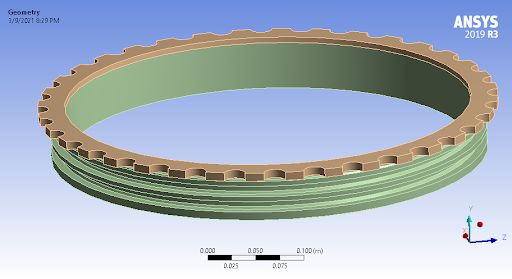
Figure 1

Team 3
Team Members |
Faculty Advisor |
Christopher Rowley |
Ryan C. Cooper Sponsor Aerogear |
sponsored by

This project considers the geometric and material design of a quench plug that prevents distortion. Distortion happens during the hardening heat treatment processes. The heat treatment processes for the hardening of metal parts impose a variety of thermal and mechanical stresses that can result in geometric and microstructural weaknesses depending on the initial geometry and material of the part. For the investigation of this design, constraints provided by the aerospace manufacturer, Aero Gear, are considered. During the heat treatment process, as the quench plug and ring gear expand, they must experience interference that does not occur until the oven temperature reaches 1315°F. This interference must not exceed a limit of 0.008”. After the ring gear undergoes heat treatment with the support of the quench plug, it must maintain a roundness measurement of its inner and outer diameters within 0.010”. Finally, this design must be able to withstand 50 heat treatment cycles. In addition to these constraints, a design that maximizes the strength to weight ratio of the quench plug is desired. Minimizing the thickness of the plug is the factor considered to optimize this ratio. We designed a thermomechanical analytical model to optimize thicknesses for each of the considered quench plug materials using the maximum shear stress theory in relation to the critical buckling of the plug. A thermomechanical analysis (TMA) experiment using a dilatometer was used to find variable coefficient of thermal expansion (CTE) values over a range of temperatures. Using a computer aided design (CAD) model of the quench plug, we performed thermal simulations in Ansys. Using the simulations, we were able to visualize the heat treatment processes and verify the results from the analytical model.
